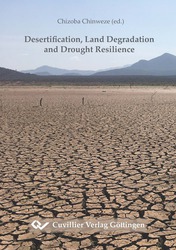| Areas | |
|---|---|
| Serie de libros (96) |
1378
|
| Nachhaltigkeit |
3
|
| Gesundheitswesen |
1
|
| Letra |
2365
|
| Ciencias Naturales |
5406
|
| Matemática | 229 |
| Informática | 319 |
| Física | 980 |
| Química | 1363 |
| Geociencias | 131 |
| Medicina humana | 243 |
| Estomatología | 10 |
| Veterinaria | 108 |
| Farmacia | 147 |
| Biología | 835 |
| Bioquímica, biología molecular, tecnología genética | 121 |
| Biofísica | 25 |
| Nutrición | 45 |
| Agricultura | 1004 |
| Silvicultura | 201 |
| Horticultura | 20 |
| Ecología y conservación de la tierra | 148 |
| Ciencias Ingeniería |
1793
|
| General |
98
|
|
Leitlinien Unfallchirurgie
5. Auflage bestellen |
|
Erweiterte Suche
Desertification, Land Degradation and Drought Resilience (Tienda española)
Chizoba Chinweze (Editor)Previo
Lectura de prueba, PDF (730 KB)
Indice, PDF (160 KB)
A growing body of research and scientific as well as local evidence has shown that climate change impacts is on the rise with its attendant risks/hazards for the land system, even as it relates to DLDD, these being exacerbated by anthropogenic factors; thus, pushing the earth system to a tipping point therefore requiring that society braze up its coping capacities to avert the impending danger.
This book highlights the urgent need to move from desertification, land degradation and drought (DLDD) risk management to resilience. The aim is to provide new insight on the issues of DLDD and stir policy guide on vulnerability reduction and building adaptive capacities so as to achieve sustainable development and identify pathways to a land degradation neutral world.
It is worthy to note that globally, about one fifth of earth’s land area – more than 2 billion hectares – is degraded; and this jeopardizes the livelihoods of more than 3.5 billion people, i.e., about 40% of the world population. The global population is still growing and is projected to reach 8.3 billion people by 2030. Such growth will put unprecedented pressure on the productivity of the land system from day to day.
| ISBN-13 (Impresion) | 9783736977839 |
| ISBN-13 (E-Book) | 9783736967830 |
| Formato | A5 |
| Idioma | Inglés |
| Numero de paginas | 328 |
| Laminacion de la cubierta | mate |
| Edicion | 1. |
| Lugar de publicacion | Göttingen |
| Fecha de publicacion | 25.05.2023 |
| Clasificacion simple | Libro de divulgacion |
| Area |
Ecología y conservación de la tierra
|
| Palabras claves | Resilience, Desertification, Land Degradation, Drought, Food Security, Climate Change, Net Zero, Wüstenbildung, Bodendegradation, Dürre, Bodenverschlechterung, Ernährungssicherheit, Klimawandel, Land, zero land degradation, vulnerability, response, resilience and sustainable development, Land, Null-Bodenverschlechterung, Anfälligkeit, Reaktion, Widerstandsfähigkeit und nachhaltige Entwicklung, Drought risk, water stress, drylands, impacts, climate change and Sustainable Development Goals (SDG), Dürrerisiko, Wasserstress, Trockengebiete, Auswirkungen, Klimawandel und nachhaltige Entwicklungsziele (SDG), governance, decision making, stakeholders, resilience, early warning system (EWS), disaster monitoring, mitigation and response, Governance, Entscheidungsfindung, Interessengruppen, Widerstandsfähigkeit, Frühwarnsystem (EWS), Katastrophenüberwachung, Schadensbegrenzung und -bekämpfung, anthropogenic climate change, farming social justice, and North Pacific jet stream, Anthropogener Klimawandel, soziale Gerechtigkeit in der Landwirtschaft und nordpazifischer Jetstream, Green wall, Sahel, Sahara, African Union, livelihoods, Grüne Wand, Sahel, Sahara, Afrikanische Union, Poverty, Sudano-Sahelian Region, Armut, Sudano-Sahelische Region |








